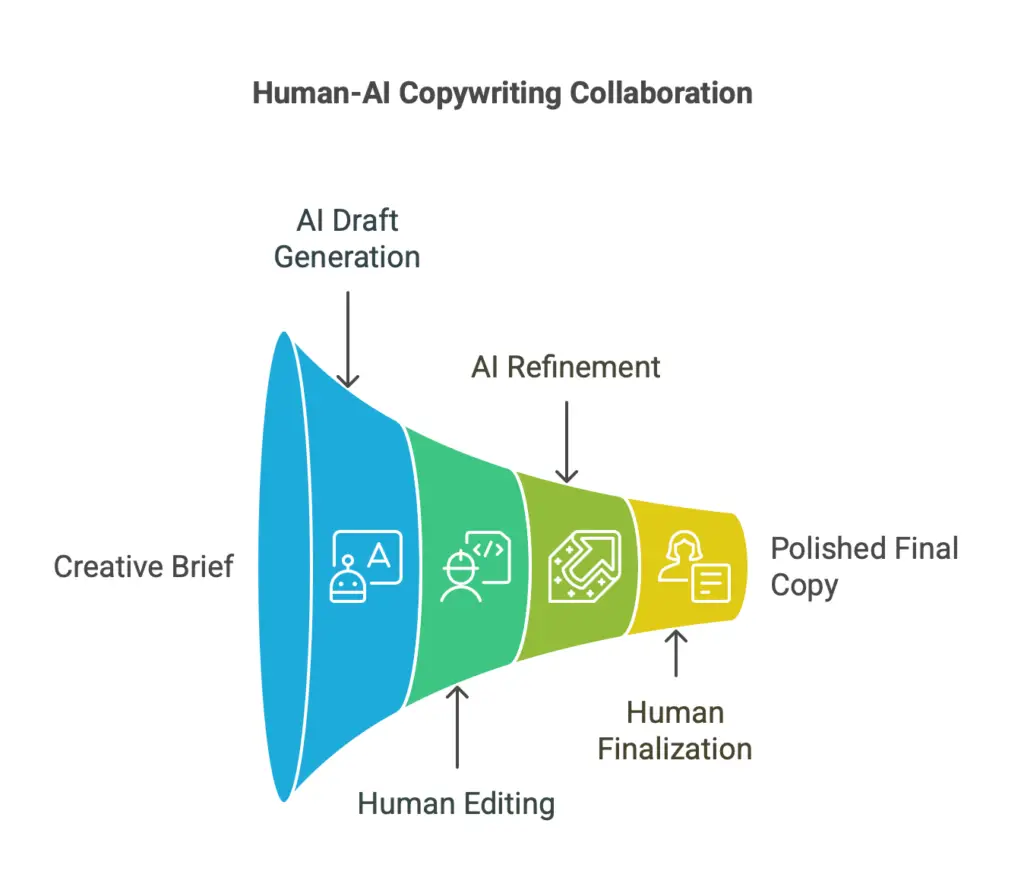A staggering 87% of marketing teams that adopted AI copywriting tools reported completing campaigns 3x faster than with traditional methods, according to recent industry research. This technology is rapidly changing how businesses create content, with AI-generated copy now powering everything from email campaigns to product descriptions for major brands worldwide.
Just two years ago, a mid-sized e-commerce company struggled to maintain product descriptions for their 5,000+ inventory items. Three copywriters spent weeks creating content that often failed to convert. After using AI copywriting tools, they now refresh all product descriptions weekly. They’ve increased conversion rates by 32% and moved their copywriters to high-value creative strategy work. This shift shows how AI writing tools can create human-like text that drives results while scaling easily.
Understanding AI Copywriting Technology
What Defines AI Copywriting Tools
AI copywriting tools use smart algorithms to study large amounts of existing content and learn language patterns. These systems then create new text based on what you ask them to write. Unlike old templates, AI writing can match different tones, styles, and topics, making it useful for many types of content.
According to a study by Gartner, 30% of outbound marketing messages from large organizations will be created by AI by 2025. This shows a big shift in how companies are making and sharing content.
The main parts of AI copywriting systems include natural language processing engines, machine learning algorithms, training data from human-written content, and user-friendly interfaces. These parts work together to understand context, create relevant ideas, and produce clear text that aligns with marketing goals.
The Evolution of AI Copywriting Systems
AI copywriting started with basic rule-based systems that followed set templates. As machine learning improved, better models emerged. Early versions could only finish sentences or suggest simple phrases. Today’s systems can write entire blog posts, product descriptions, and ad campaigns.
Research from the Stanford Artificial Intelligence Index Report shows that natural language processing has improved greatly since 2018. Today’s models can create text that often passes human review tests.
This progress continues as developers add new features. AI can now match emotional tones in content and target specific audiences. It can also keep your brand voice consistent and create content in many languages. As these tools get better, they become more useful for all types of businesses.
Key Benefits of AI Copywriting for Businesses
Efficiency and Productivity Improvements
One of the biggest benefits of AI copywriting is how much faster it makes content creation. What might take a human writer hours can be done in minutes with AI help. This speed lets marketing teams create more content across many channels at once.
According to a report by Accenture, businesses using AI in their content work see up to 40% higher productivity in creative tasks, including writing.
The benefits go beyond just speed. AI systems provide steady output no matter the time pressure. They can make many content versions to test different approaches. They also help create content in different formats quickly, from social posts to long articles. Most importantly, they reduce bottlenecks in marketing, letting teams focus on strategy. For marketing teams with tight deadlines or limited staff, these gains can be game-changing.
Cost-Effectiveness of Implementing Solutions
Beyond saving time, AI copywriting offers big cost benefits. While skilled copywriters charge premium rates, AI tools usually work on subscription plans that provide unlimited or high-volume content at a fixed price.
Research from Forrester shows that companies using AI for content creation report an average 33% drop in content production costs while keeping or improving quality.
These cost benefits help many types of businesses. Small businesses with tight marketing budgets can create professional content without hiring costly specialists. Startups that need to build content libraries quickly can grow their online presence more affordably. E-commerce businesses with large product catalogs benefit from automatic description creation. Marketing agencies can scale their services while keeping prices competitive. The return on investment looks even better when you consider fewer revisions and the ability to use human resources for more strategic work.
Popular AI Copywriting Tools in the Market
Comprehensive Analysis of Leading Platforms
The market for AI copywriting tools has grown quickly, with options for different needs and skill levels. Popular platforms include Jasper, Copy.ai, and Writesonic, each with unique features.
A comparative analysis by G2 shows that the best AI copywriting tools can understand context, maintain flow in longer pieces, and adapt to specific brand voices.
Tools differ in several key ways. The sources and size of training data directly affect content quality and variety. Available templates vary greatly, with some platforms offering special solutions for specific industries. How well they work with your existing marketing tools matters for smooth workflows. The ease of use affects how quickly your team can start using them. Pricing models and content limits determine the value for different organization sizes. This variety lets businesses pick tools that match their specific content needs and technical skills.
Selecting the Right AI Copywriting Tool for Your Needs
With so many options, choosing the right AI copywriting solution requires careful thought. The best tool should fit your specific use cases, budget, and technical needs.
According to research by HubSpot, the most successful uses of AI copywriting tools happen when businesses clearly define their content goals and evaluate platforms based on those specific needs rather than general features.
When choosing a tool, consider what content types you need, whether social media, long articles, or product descriptions. Check how it works with your existing systems. Look at language and tone options to match your brand voice. Consider how easy it is to learn and use. Evaluate support and training resources. Finally, look at pricing and how it can grow with your needs. By looking at these factors, businesses can find the AI copywriting solution that best fits their unique needs.
Practical Applications of AI Copywriting
AI Copywriting for Marketing Campaigns
Marketing campaigns gain greatly from AI copywriting. From email subject lines that improve open rates to ad copy that drives conversions, AI tools can create and test many versions quickly.
A study by Phrasee found that AI-optimized copywriting improved email marketing results by an average of 41% across many industries, showing how well it works in campaigns.
Marketing uses are wide and varied. Email marketing sequences benefit from personalized messages that adapt to recipient behavior. Social media ad copy can be tailored to different platforms and audiences. PPC ad headlines and descriptions enable more testing. Landing page copy testing helps find the most effective conversion messaging. Promo offer messages can be customized based on past customer responses. The ability to create many versions quickly also enables A/B testing at scale, helping marketers find the most effective messaging through data rather than gut feeling.
Using AI Copywriting for Website Content
Website content creation is another valuable use for AI copywriting. From product descriptions to blog posts, these tools can help keep fresh, relevant content across your site.
According to research by Semrush, websites that regularly update their content using AI-assisted methods see an average 34% increase in organic traffic compared to those with static content.
Website content uses extend throughout the site. Product descriptions for e-commerce can be customized at scale while keeping consistent quality. FAQ page creation and updates help address common customer questions fully. Blog post drafting speeds up content schedules. Service page content optimization improves conversion rates. About page versions let you test different company stories. While human review remains important for brand alignment and factual accuracy, AI copywriting greatly speeds up website content creation.
Limitations and Challenges
Understanding the Constraints of Current AI Copywriting Technology
Despite impressive abilities, AI copywriting has important limits. Current systems may struggle with highly technical content, emotional appeals, or truly original creative concepts.
Research from the MIT Technology Review indicates that even advanced language models have limits in understanding context beyond their training data and may produce content that sounds right but contains factual errors.
Common limits include trouble with specialized industry terms where training data is limited. Many systems find it hard to maintain a consistent story across very long content, sometimes creating repetitive or contradictory statements. A limited grasp of cultural nuances can lead to inappropriate content for certain audiences. Without specific guidance, AI might generate generic content that lacks a distinctive voice. Perhaps most importantly, AI systems cannot conduct original research, relying instead on existing information. Understanding these limits helps businesses set realistic expectations and implement proper review processes.
Ethical Considerations in AI Copywriting
The rise of AI copywriting also brings important ethical questions about transparency, originality, and human creativity. Businesses must handle these concerns carefully to maintain consumer trust.
A survey by the Content Marketing Institute found that 67% of consumers expect transparency when content is mainly generated by AI, suggesting the importance of ethical disclosure.
Key ethical concerns span several areas. Disclosure of AI usage in content creation builds transparency with audiences. Fact-checking AI-generated content ensures accuracy and trustworthiness. Avoiding overstating AI abilities prevents consumer disappointment. Copyright and intellectual property questions need addressing as legal frameworks evolve. Additionally, the impact on human creative professionals raises important questions about the future of creative work. Creating clear organizational policies around these issues helps ensure the responsible use of AI copywriting technologies.
Best Practices for Optimizing AI Copywriting Results

Effective Prompting Techniques for AI Copywriting
The quality of AI-generated copy largely depends on the quality of the prompts you provide. Learning to craft effective prompts is key to getting good results from these tools.
According to research by OpenAI, well-structured prompts that include context, desired outcomes, and specific parameters can improve the relevance and quality of generated content by up to 80% compared to vague instructions.
Effective prompting strategies focus on several key elements. Including specific audience information helps the AI tailor content to target readers. Defining clear content goals ensures alignment with marketing objectives. Specifying tone, style, and brand voice parameters maintains consistency. Providing examples of preferred outputs guides the AI toward desired results. Setting content length and structure requirements helps generate properly formatted text. Mastering these techniques helps organizations consistently produce high-quality content with AI.
Human-AI Collaboration in Copywriting Projects
The most successful uses of AI copywriting follow a collaborative model, where human creativity combines with AI efficiency and data processing abilities.
A study published in Harvard Business Review found that hybrid human-AI workflows in content creation showed a 73% improvement in both quality and efficiency compared to either purely human or purely AI approaches.
Effective collaboration sets clear roles and tasks. Using AI for initial drafts and humans for refinement leverages the strengths of both. Implementing human review ensures accuracy. Allowing AI to generate variations of human-created concepts expands creative options. Training AI systems with your company’s successful content improves relevance and brand alignment. Developing clear workflows that define human and AI responsibilities ensures consistent quality. This collaborative approach uses the strengths of both human creativity and AI capabilities.
The Future of AI Copywriting
Emerging Trends in AI Copywriting Development
The field of AI copywriting continues to evolve quickly, with several emerging trends pointing to future capabilities. These developments will further expand how useful these tools are for marketing and content creation.
According to projections from McKinsey & Company, upcoming advances in generative AI will increasingly allow for more personalized, contextually aware content that adapts to individual user behaviors and preferences.
Key emerging trends are shaping the future. Multi-modal AI that combines text, image, and video creation will create more complete content packages. Better personalization for individual recipients will improve engagement. A better understanding of emotional nuances and cultural contexts will enhance messaging effectiveness. Improved factual accuracy with real-time information checking will increase trustworthiness. Enhanced abilities for longer narrative content will expand applications to more complex formats. These developments will continue to expand the possible uses for AI copywriting.
How AI Copywriting Will Transform Content Creation
Looking forward, AI copywriting is set to fundamentally transform content creation processes across industries. Rather than replacing human creativity, these tools will likely redefine creative roles and enable new possibilities.
Research from Deloitte Digital suggests that by 2026, more than 60% of content creation workflows will involve AI at some stage, with human roles evolving toward strategy, oversight, and creative direction.
Expected changes include a shift from content creation to content curation and strategy as AI handles more routine writing tasks. The spread of content production across organizations will allow more departments to produce quality content without specialized skills. New AI prompt engineering jobs will create new career paths. Higher expectations for content personalization from consumers will raise standards. New metrics for content performance will emerge to assess AI-generated content and AI-human collaborative outputs. Organizations that adapt to these changes proactively will be best positioned to leverage AI-generated content for competitive advantage.
Frequently Asked Questions About AI Copywriting
What is AI copywriting, and how does it work?
AI copywriting uses machine learning to create human-like text based on prompts. These systems study patterns in existing content to understand language structure, tone, and context, then produce new content following similar patterns.
Can AI completely replace human copywriters?
While AI can create impressive content, it works best as a helper with human oversight. AI is fast and can create a lot of content but may lack the creative insight, emotional intelligence, and strategic thinking that human copywriters provide.
How accurate is AI-generated content?
AI-generated content can sound convincing but may contain factual errors. Human checking remains essential, especially for technical content or claims that require accuracy.
What types of copy work best with AI generation?
AI copywriting works well for structured formats like product descriptions, social media posts, ad copy, and email subject lines. More complex content typically requires more human involvement.
Is using AI for copywriting ethical?
Ethical use of AI copywriting involves being transparent with audiences, properly attributing when required, fact-checking generated content, and establishing clear policies around AI usage in your organization.
How much does AI copywriting cost compared to human writers?
Most AI copywriting tools use subscription models ranging from $20-$500 monthly, depending on features and volume. While often less expensive than professional copywriters, you should consider quality, originality, and strategic input when comparing value.
Will Google penalize AI-generated content?
Google’s guidelines focus on content quality rather than how it was created. High-quality, valuable, and original AI-generated content with human oversight generally performs well, while low-quality, mass-produced AI content may face penalties.
How can I get started with AI copywriting?
Begin by identifying specific use cases where AI can add value. Research platforms that specialize in those applications. Start with small projects to build familiarity. Establish clear workflows for human review and refinement.
References
- (2023). Generative AI for Content Creation. Gartner Research.
- Stanford University. (2023). Artificial Intelligence Index Report. Stanford HAI.
- (2023). The Business Case for Generative AI. Accenture Research.
- (2023). The Total Economic Impact of AI Solutions. Forrester Research.
- (2023). AI Writing Assistant Software Comparison. G2 Research.
- (2023). AI Marketing Adoption Report. HubSpot Research.
- (2023). AI Marketing Language Report. Phrasee Research.
- (2023). AI Content Creation Survey. Semrush Blog.
- MIT Technology Review. (2023). Limitations of Large Language Models. MIT Technology Review.
- Content Marketing Institute. (2023). AI Content Creation Research. Content Marketing Institute.
- (2023). GPT-4 System Card. OpenAI Research.
- Harvard Business Review. (2021). AI Doesn’t Have to Be Too Complicated or Expensive for Your Business. Harvard Business Review.
- McKinsey & Company. (2023). An Executive’s Guide to AI. McKinsey Digital.
- Deloitte Digital. (2023). AI Content Creation Trends. Deloitte Digital Research.





2 Responses